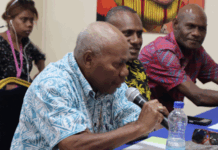
In the wake of the worst ever cyclone to have hit Fiji, the tourist destination is gearing to overcome a new challenge – combating the spread of the zika virus. Anuja Nadkarni files for Asia Pacific Report.
The mosquito-borne disease zika has spread to Fiji, but the island nation is taking charge.
Seventeen confirmed cases of zika have so far been recorded in Fiji, according to Sunil Chandra, spokesman of the Fijian Ministry of Health.
![]() Chandra says the ministry, along with other government agencies and not-for-profit organisations, will be a holding a national clean-up campaign to “destroy the mosquito breeding places to prevent the spread of the virus”.
Chandra says the ministry, along with other government agencies and not-for-profit organisations, will be a holding a national clean-up campaign to “destroy the mosquito breeding places to prevent the spread of the virus”.
“This will be a month long campaign and it is anticipated that the people and the municipality will work closely to address the issue.”
A senior lecturer of physiology at the University of Fiji, Dr Abhijit Gogoi, says since tourism is vital to Fiji’s economy it has been a concern for the island nation since natural disasters and fears of infectious diseases can potentially affect numbers of inbound tourists. But he adds that the country is resilient.
“Tourism is a concern whenever there is a panic. First HIV, then SARS, then chickungunya and now zika … Every time there is a disaster or an epidemic, the country that depends so much on tourism for the economy does get affected by the sudden decrease in tourist inflow.
“But until now the tourism industry has not been affected here because of zika virus.”
Likewise, a report released from the Fiji Bureau of Statistics shows no effect on tourism as of March 2016 despite news reports of zika in Fiji. The number of visitors for March increased by nearly 10 percent compared to a year earlier. The report also showed that some 74 percent of all visitors were tourists.
Widespread mosquito carrier
A study of the zika virus in the South Pacific by Jose Derraik and David Slaney published last year suggests that the Aedes aegypti species of mosquito is the primary carrier of the virus and is widespread in the South Pacific.
The virus was first isolated from a monkey in the Zika Forest in Uganda in 1947, the study says.
Auckland University infectious disease specialist Siouxsie Wiles says that because the mosquito is widespread in the region, which has humid environmental conditions where these mosquitos can thrive, it was a matter of time before Fiji would be affected.
“It’s just the perfect storm of getting it to the right place at the right time with an abundance of mosquitoes and an abundance of people.”
Similarly, Auckland University’s Liggins Institute senior research fellow Dr José Derraik says although it is possible that the global spread of the zika virus has been caused by a mutation since its discovery in 1947, it is more likely that the more people travelling to places that have been struck by the zika virus has caused the epidemic to grow faster.
“The rapid movement of people across the world also means that zika virus has been introduced by infected travellers into new areas, where local populations had never been exposed to it. Consequently, as they had no associated immunity, zika virus was able to spread quickly,” Dr Derraik says.
He says, the fact that most people are asymptomatic is also a reason why the virus has been able to spread, as “infected travellers without any symptoms can freely travel from one country to another”, he says.
Dr Wiles explains that the mosquitoes that carry the virus are pregnant females that lay more than one batch of eggs.
Unaware of infection
Dr Derraik says some estimates suggest that 80 percent of the people infected with zika virus are unaware that they have been infected.
The study by Derraik and Slaney shows that the clinical presentation of the disease includes illnesses similar to influenza but in some extreme cases it can also cause cardiac complications and death.
Dr Wiles says evidence is building to show that the zika virus can also cause the Guillan-Barre syndrome, which is well known to happen following infection from a range of viruses.
“It’s a syndrome that can give people muscle weakness, affect people’s breathing and kill them but all of the people that have had the syndrome actually recover quite well.”
She says researchers are also studying whether the disease can be passed on from mother to child as there have been numerous cases in Brazil of children born with microcephaly, a congenital condition associated with stunted brain development, since the outbreak last year.
Dr Gogoi says there is also the probability that this virus could be transmitted sexually.
“As of now there are 8 cases of zika virus reported to be transmitted sexually in Brazil and Haiti.”
Dr Wiles says treatment for the virus has not been found yet because of a lack of resources for research until very recently.
“It’s not something people have been researching to find a cure because it wasn’t thought to be that devastating.”
Methods of control
Dr Wiles says, “the only way to get rid of it [zika] is to get rid of the mosquito.” And she says the most effective way of doing this would be to release genetically modified sterile male mosquitos.
“When they are released and breed with the females the young can’t survive. These genetically modified mosquitoes are released in large numbers so they outcompete the normal males so that when the females breed with the wrong males they don’t get any viable offspring.”
Dr Derraik suggests if measures to prevent getting bitten are taken then travellers need not avoid countries affected by the virus. However, he says the situation is different for pregnant women in light of the association with microcephaly in the foetus.
Dr Gogoi says employing measures of hygiene, using mosquito repellents and nets and ensuring no storage of water in any open rubbish containers or coconut shells, can help contain the spread of the virus.
Anuja Nadkarni is a journalism graduate from AUT University and is currently completing her Honours degree in Communication Studies. She is on the Asia-Pacific Journalism Studies course at the Pacific Media Centre.












































